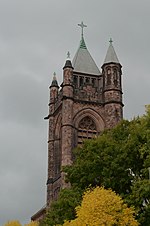The World Video Game Hall of Fame is an international hall of fame for video games. The hall's administration is overseen by The Strong's International Center for the History of Electronic Games, and is located at The Strong National Museum of Play in Rochester, New York, United States. The museum began the International Center for the History of Electronic Games in 2009, announced the formation of the hall of fame in February 2015, and opened it on June 4, 2015. It is located in a dedicated part of the "ESL Digital Worlds: High Score" exhibit at the National Museum of Play; prior to an expansion of the museum in 2023 it was located in the museum's "eGameRevolution" exhibit. The Strong has also run the National Toy Hall of Fame since 2002.Video games become eligible for the World Video Game Hall of Fame by meeting four criteria:
Icon Status – is widely recognized and remembered
Longevity – is more than a passing fad and has enjoyed popularity over time
Geographical Reach – meets the above criteria across international boundaries
Influence – has exerted significant influence on the design and development of other games, on other forms of entertainment, or on popular culture and society in generalInitial nominations are made each year by a staff committee at The Strong, which takes into account the four criteria, with influence considered the most important. Members of the public can submit games for consideration by the committee as well. The nominees are then voted on by a panel of around 30 "scholars and journalists from around the world", with each panel member ranking their top three choices. A public poll is also included, with the results counting as equivalent to a member of the panel. Afterwards, the staff committee reviews the votes and makes the final selection. While generally there is a clear difference in vote counts for the highest-scoring games, if there are multiple games with similar vote counts near the cutoff point, the committee decides by emphasizing a variety of game types or platforms in any given induction year. Video games that have not been inducted may be nominated in multiple years. The set of final nominees is typically announced each year in March, and the inductees in May. In its first two years of operation, the hall named six inductees from fifteen finalists; since then, it has named four inductees each year from a set of twelve.
In the nine years that the hall of fame has been open, 40 games have been inducted out of 74 nominated. Many of those games have been nominated multiple times. In some cases, the hall may list the first game in a series of similar titles as a proxy for the entire series, such as with The Oregon Trail series or the FIFA International Soccer/FIFA series. Nintendo has been the developer of the most games inducted with six, out of a total of nine nominations of seven games. Atari has had three games inducted out of five nominations of four games, and Blizzard Entertainment has had two games inducted, both on their first nomination. Eight other developers have had more than one game nominated. Minecraft has had the most nominations of any game at four and was then inducted, while FIFA International Soccer has had the most nominations without being inducted at three. The earliest game to be nominated is Spacewar! from 1962, while the latest is The Last of Us from 2013, both of which have been inducted.










